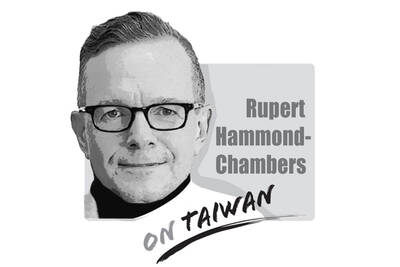With the presidential election looming, the nation is almost overwhelmed with an onslaught of disinformation and misinformation. That is not news though. The same phenomenon indirectly cost a diplomat’s life last year, created a widening fissure in society and interfered with the local elections.
Apparently, the government has learned its lesson and has been stretched thin clarifying endless falsehoods. It has also tried to reinforce punitive laws for the fake news deluge.
Unfortunately, once a false impression has been implanted in people’s minds, it is not easily erased. Taiwan is not the only place struggling with a surge of falsehoods. Plenty of countries are in this together.
There are definitely “bad actors” operating behind the scenes, but it seems impossible that the shadow puppets will succumb to their conscience, so what can be done to stop this fierce penetration?
At the same time, people should reflect on why they are so incapable of critical thinking.
Freedom of speech and freedom of the press are the invaluable constituents of a democratic nation, but nowadays, they are used as the most powerful and cheapest weapons to harm democracy.
In Taiwan’s case, the dark forces behind this activity are suspected of mainly emanating from China, which persists in its pursuit of unification with Taiwan.
Infiltrating Taiwan’s media industry is one of the methods it uses. The so-called “red media” has been spreading pro-China, anti-Taiwan information for some time.
In addition, it seems that the bad actors have recruited an army of trolls, who spread a cascade of memes that convey falsehoods with distorted content to harm officials’ reputations or dismiss the government’s achievements.
It is true that the Taiwanese government has begun to take some measures to tackle this issue, including enforcing laws, making clarifications on official Web sites, and appealing to the media and the public for morality.
There are also some civil groups dedicated to detecting and clarifying fake news. The mass rally against the red media in Taipei on June 23 showed that most people are no longer willing to stand by and let the red media influence politics and society.
However, it is not enough if individuals do not take responsibility. Taiwanese should dig into the sources of information and look for balanced reports before believing a story or passing it on to friends.
It is easy to recognize suspicious information if it is obviously out of the norm, but sometimes the information is a half-truth. In that case, if a person cannot conquer their unreasonable emotions and prejudice, they are highly likely to accidentally become accomplices.
The more hatred a person feels, the greater the need to understand the whole story. Otherwise, they become nothing more than pawns for the bad actors.
People tend to stay in their echo chambers, but if everyone always jumps to conclusions and takes the bait without a second thought, the fissure in Taiwanese society will never be healed — and that is just the ticket the bad actors want.
Everyone knows that the falsehoods not only come from the red media, but also people who hold a grudge against someone or the government.
Victims are increasingly taking a more proactive approach, and dealing with the defamation through the courts. People should be educated that everyone must be responsible for whatever they say or do.
On the other hand, the victims of falsehoods also should stand up to fight the initiators of evil. It is especially true for the government.
Janet Hung is a physical therapist.

In the past month, two important developments are poised to equip Taiwan with expanded capabilities to play foreign policy offense in an age where Taiwan’s diplomatic space is seriously constricted by a hegemonic Beijing. Taiwan Foreign Minister Lin Chia-lung (林佳龍) led a delegation of Taiwan and US companies to the Philippines to promote trilateral economic cooperation between the three countries. Additionally, in the past two weeks, Taiwan has placed chip export controls on South Africa in an escalating standoff over the placing of its diplomatic mission in Pretoria, causing the South Africans to pause and ask for consultations to resolve
An altercation involving a 73-year-old woman and a younger person broke out on a Taipei MRT train last week, with videos of the incident going viral online, sparking wide discussions about the controversial priority seats and social norms. In the video, the elderly woman, surnamed Tseng (曾), approached a passenger in a priority seat and demanded that she get up, and after she refused, she swung her bag, hitting her on the knees and calves several times. In return, the commuter asked a nearby passenger to hold her bag, stood up and kicked Tseng, causing her to fall backward and
In December 1937, Japanese troops captured Nanjing and unleashed one of the darkest chapters of the 20th century. Over six weeks, hundreds of thousands were slaughtered and women were raped on a scale that still defies comprehension. Across Asia, the Japanese occupation left deep scars. Singapore, Malaya, the Philippines and much of China endured terror, forced labor and massacres. My own grandfather was tortured by the Japanese in Singapore. His wife, traumatized beyond recovery, lived the rest of her life in silence and breakdown. These stories are real, not abstract history. Here is the irony: Mao Zedong (毛澤東) himself once told visiting
When I reminded my 83-year-old mother on Wednesday that it was the 76th anniversary of the founding of the People’s Republic of China, she replied: “Yes, it was the day when my family was broken.” That answer captures the paradox of modern China. To most Chinese in mainland China, Oct. 1 is a day of pride — a celebration of national strength, prosperity and global stature. However, on a deeper level, it is also a reminder to many of the families shattered, the freedoms extinguished and the lives sacrificed on the road here. Seventy-six years ago, Chinese Communist leader Mao Zedong (毛澤東)